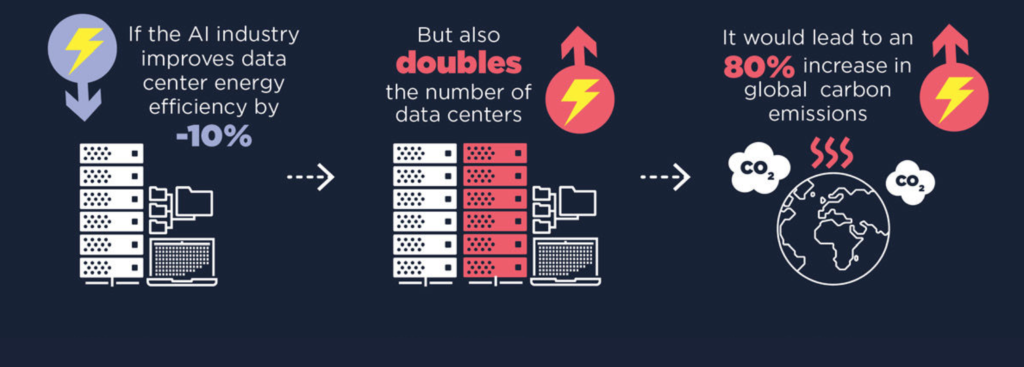Artificial intelligence (AI) is growing rapidly, but its high energy and water consumption is threatening the environment and could exacerbate climate change.
Although it is a new technology, AI has become increasingly integrated into our daily lives, often without us thinking about or considering its long-term impact.
This trend can be seen not only among ordinary consumers, but also among technology leaders and investors, who highlight the promising advances of AI, from curing diseases to optimising industrial processes. But a closer look reveals a major concern: AI’s intense energy consumption.
This increase in energy consumption is not trivial, as it has a direct impact on climate change. As data centres and AI infrastructures consume more energy, they often rely on non-renewable energy sources, contributing to increased greenhouse gas emissions.
This dynamic exacerbates global warming and contradicts the promises of some AI applications that claim to reduce carbon footprints. Therefore, the relationship between the advancement of AI and increasing energy consumption requires careful analysis and mitigation measures to align technological development with global environmental goals.
The AI industry is already recognising that its systems require huge amounts of energy. Sam Altman, CEO of OpenAI, recently admitted that AI consumes far more energy than previously thought, and estimates suggest that energy use in AI-powered data centres could double in the next two years, consuming an amount equivalent to that of Japan. In addition, the training of AI models consumes astronomical amounts of energy, with ChatGPT-3 using as much energy as 120 US homes over the course of a year.
As well as the direct impact of AI, there are also concerns about its use in other industries. Companies, including oil and gas giants, are using AI to increase the efficiency of their operations, even if it means extracting more fossil fuels from the ground. This not only perpetuates our dependence on non-renewable energy sources, but also exacerbates existing inequalities, with marginalised communities bearing the brunt of AI’s environmental impacts.
The International Energy Agency (IEA), which aims to coordinate collective responses to major oil supply and other energy-related challenges, published data in its report on the significant increase in electricity consumption by data centres, artificial intelligence (AI) and the cryptocurrency sector expected by 2026. These data centres have become a key driver of electricity demand growth in several regions of the world.
According to the IEA, recent data suggests that these global centres will consume around 460 terawatt hours (TWh) of electricity by 2022. However, projections suggest that this figure could more than double to over 1,000 TWh by 2026. To put this in perspective, this amount of electricity is roughly equivalent to the energy consumption of the whole of Japan.
To meet this growing energy demand, experts stress the urgent need for regulatory updates and technological improvements. These measures, including advances in energy efficiency, are seen as crucial to mitigating the rising energy consumption of data centres and AI, while ensuring a reduction in the environmental impact and efficiency of these evolving technologies.

AI-generated water consumption:
In addition to this massive energy consumption, there is another issue related to the increasing use of artificial intelligence: its water consumption. According to recent information, AI models consume a significant amount of water in two main ways: cooling the servers on-site and generating electricity off-site.
To keep AI servers from overheating, data centres use cooling methods that require significant amounts of clean, fresh water. These include the use of cooling towers and outside air, which rely on water evaporation to produce chilled water and control humidity. In addition, the generation of electricity to power these servers also uses large amounts of water, especially in thermal, nuclear and hydroelectric power plants.
The impact of AI water use does not stop there. Global demand for AI could require between 4.2 and 6.6 billion cubic metres of water by 2027, an amount greater than the total annual water consumption of several European countries. This growing demand is being driven by the rapid expansion of technology across multiple sectors, including leading technology companies such as Google and Microsoft, which have seen a significant increase in water consumption in their data centres.
Experts warn that while we have not yet reached a stage where AI is depleting our vital natural water resources, increased water consumption by technology is a growing concern. As water scarcity becomes a major global challenge, especially in drought-prone regions, excessive water use by AI could exacerbate the situation.
Tensions between AI data centres and local communities are already evident, with growing concerns about the disproportionate use of water resources. If measures are not taken to mitigate excessive water consumption by AI, these pressures could intensify and lead to social conflict.
In this context, experts stress the need for a more transparent and accountable approach to AI water use. Measures to reduce water consumption and promote green practices in the technology industry are essential to address water scarcity challenges and ensure a future for all.
Conclusiòn:
Given these challenges, it is vital that we address the environmental and social impacts of AI urgently and comprehensively. Transparency and public scrutiny are essential to ensure that AI is developed and deployed in an ethical and sustainable way.
As we have seen, the exponential increase in energy consumption by AI, particularly in data centres and computing infrastructure, raises serious concerns about its impact on climate change. The reliance on non-renewable energy sources can run counter to efforts to reduce greenhouse gas emissions and meet ambitious environmental targets.
In addition, AI’s intensive use of water, both for cooling servers and generating electricity, presents an additional challenge in a world where water scarcity is an increasingly pressing reality.
We need to integrate climate and environmental justice considerations into all phases of AI development and implementation to ensure that the technology benefits everyone, not just the privileged few.



